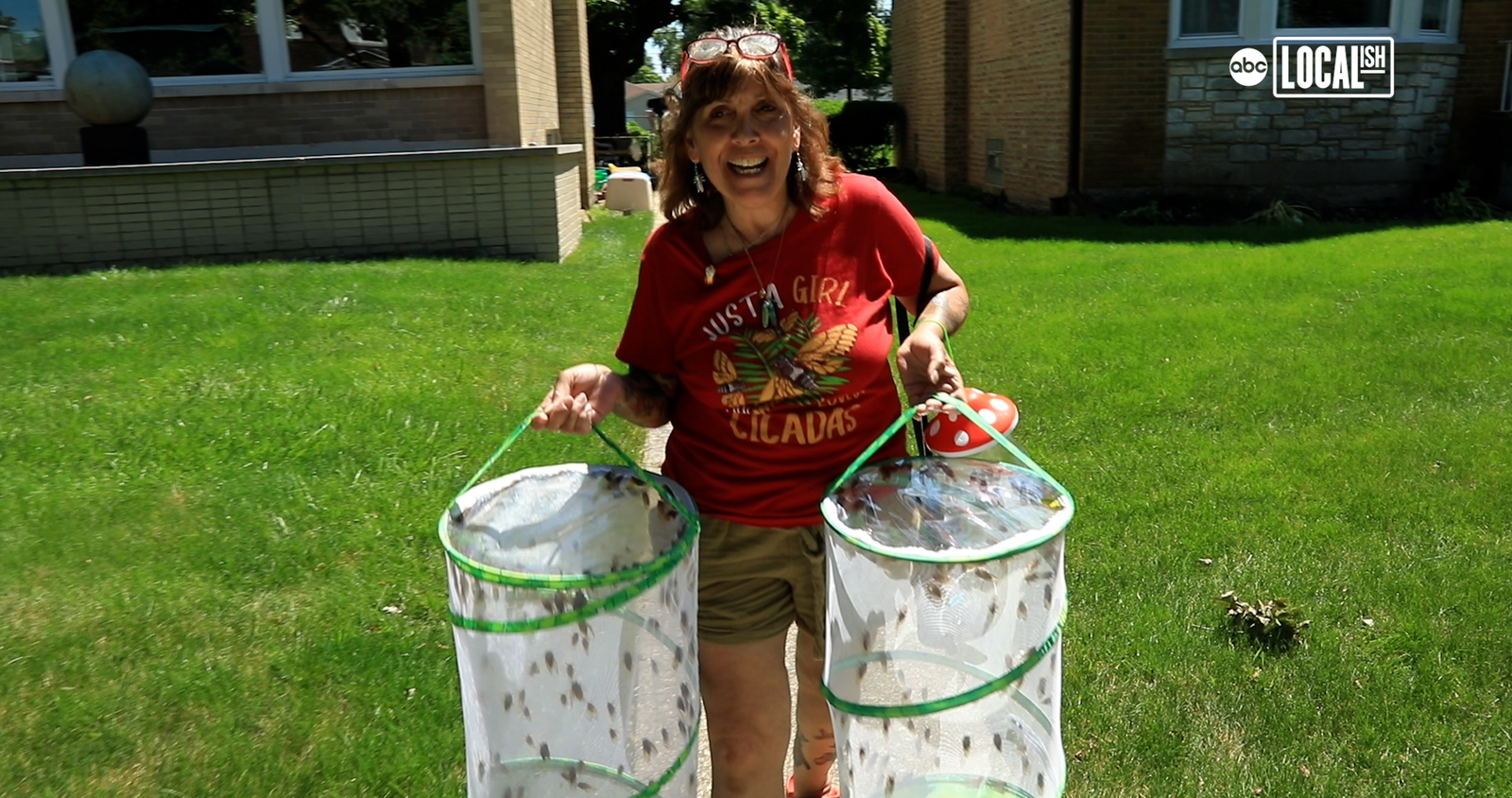NORTH AURORA, Ill. — The season of the periodical cicada is winding down in the Chicago area and the Midwest.
These insects finished up their mating season in early July and have laid their eggs to be hatched in either 13 years or 17 years.
Its a rare phenomenon. These two broods haven’t emerged simultaneously for 221 years.
And while their shrill, loud mating calls have been background noise for millions of Chicagoans, Bettina Sailer has been active at making sure her home in the west suburbs has an ample supply of these periodical cicadas when they emerge again in the upcoming decades.
Sailer, a 58-year-old woman who lives in North Aurora, just finished a unique accomplishment. She has transferred over 6,500 of the rare insects from various locations in Illinois to her home in far west suburban Aurora.
Her goal is simple. Sailer wants to populate her community with periodical cicadas when they hatch again in another 13 or 17 years.
While the periodical cicadas have flourished in certain areas, especially in the near west suburbs, North Aurora didn’t have a high influx of the insects.
So, Sailer wants to make sure that when the emerge again in 13 and 17 years, North Aurora has their fair share of the insects.
“The end game is to in fact populate North Aurora with a thriving new community of cicadas,” said Sailer, who works as an inventory specialist for Walgreens. “I live in this community, and I want to experience them as much as I can before I die.”
Its not the first time Sailer has attempted this feat. Back in 2007, she also collected periodical cicadas and planted them in trees in her yard on Oak Street in the far western suburb. That attempt was only moderately successful. Sparrows ended up eating some of the mating cicadas when she transferred them.
So now, Sailer has established a 40-by-100-foot netted sanctuary for the insects in her front yard, to ensure that they properly mate in her community and lay eggs that can hatch again in 2037 and 2041.
On a recent sweltering late June day, she was out with her daughter, Saren, collecting cicadas in near west suburban Westchester, where her grandmother lives.
The mother and daughter carried large containers used to collect butterflies as the repository for the captured cicadas, which they picked by hand out of trees and bushes in Westchester.
“We’ve already done 15 trips,” Sailer said. “We started when they first emerged in May, going to Park Ridge, then we went to Wheaton three or four times, Lombard and Riverside twice, and we’ve been in Westchester three times.”
The two then traveled back to Sailer’s North Aurora home, where they went underneath the netted sanctuary and placed the insects in the crabapple trees in the front yard.
“Be free, cicadas, be free!” Bettina Sailer would shout, while she placed the mating cicadas in the trees.
Saren Sailer, now 30, fondly remembers going out with her mother to collect periodical cicadas back in 2007, when the daughter was only 13.
“Back then, we would go to Brookfield Zoo to collect cicadas,” Saren Sailer said. “We didn’t have the sanctuary like we do now. So its nice to see 17 years later, we have this sanctuary that hopefully will contain all the cicadas.
Why is Bettina Sailer so interested in cicadas?
“I’m doing this because not only are cicadas awesome. They have a really awesome lifecycle,” Sailer said. “They’ve been around four million years and somehow evaded becoming extinct by adapting to prime numbered years where they emerge from the ground and form these choruses of beautiful sounds.”
“I also love the way they sound,” she adds. “It’s like a droning sound or white noise to me. It just makes me happy, and I’m comforted by the sounds that they make.”
She is fascinated by the insects mating process.
“They’re gonna mate, and unfortunately for the poor male who’s having a good time right now, he,s gonna die shortly after mating,” Sailer said, while holding a mating couple. “The female will go as high as she can in the trees to a softer branch, shell cuts slits in the branch, lay some eggs and then, she’ll die.”
Those eggs will then burrow in the ground, where they,ll stay until the eggs are hatched in the next 13 or 17 years.
When Sailer says cicadas are awesome, she really means it. Her body is covered with cicada tattoos and has hundreds of memorabilia items, including T-shirts, earrings and other tchotchkes that represent the insect.
“I pretty much hate most bugs because they kind of freak me out,” Sailer said. “Cicadas are one of the few insects that I like because they’re very docile. They don’t bite. They don’t sting. And they are beautiful because they have red eyes — red is my favorite color. And they have orange tipped wings, which is another of my favorite colors.”
Sailer also says that she wants to be a part of history as one of the few people to do a large-scale successful cicada transfer from one area to another. Her 2007 transfers only produced small groups of cicadas, most of which only spread from about a mile from Sailers house.
“I have a pretty modest life,” Sailer said. “My husband retired, I have two grown beautiful children and I play saxophone with the Batavia (Ill.) Community Band. So, I’m an ordinary person who has a fascination and obsession with cicadas. Now I want to see it in the science books down the line that North Aurora has cicadas because of the Sailer family.”
